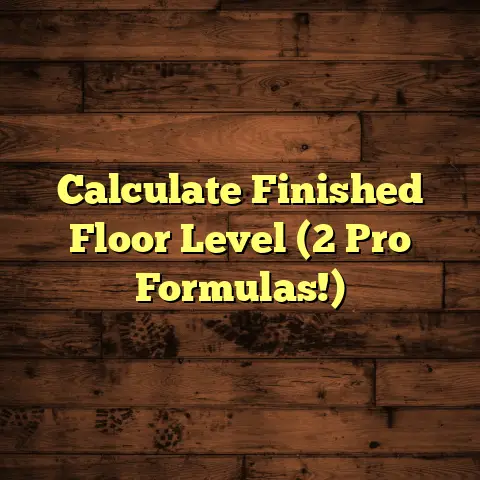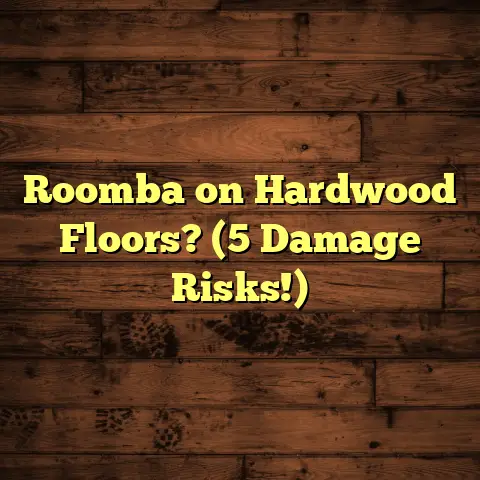Laminate or Vinyl for Kitchen? (Avoid These 3!)
Ever tripped over your own feet while trying to clean up a spill in the kitchen?
I have! And let me tell you, it wasn’t pretty.
It all started when my neighbor, bless her heart, decided to install some gorgeous (but totally impractical) tile.
One rogue splash of spaghetti sauce later, and she was doing an unintentional, slippery interpretive dance.
That’s when it hit me: choosing the right kitchen flooring isn’t just about looks; it’s about survival!
Today, we’re diving deep into the world of kitchen floors, specifically laminate and vinyl. Both are popular, but they come with their own set of pros, cons, and potential disasters.
I’m here to help you navigate this tricky terrain and avoid the three biggest pitfalls that can turn your dream kitchen into a flooring nightmare.
Section 1: Understanding
Laminate Flooring
So, what exactly is laminate flooring? Think of it as a multi-layered sandwich.
At its core, you’ve got a high-density fiberboard (HDF) or particleboard base. This gives the flooring its stability and structure.
Then comes the decorative layer – a high-resolution photograph that mimics wood, tile, or stone. Finally, a clear, protective wear layer tops it off, guarding against scratches, stains, and fading.
Unlike hardwood, which is solid wood through and through, laminate is a synthetic product designed to look like the real deal.
Benefits of Laminate
in the Kitchen
Why do so many people choose laminate for their kitchens?
Well, for starters, it’s relatively budget-friendly. Compared to hardwood or natural stone, laminate can save you a significant chunk of change.
According to HomeAdvisor, laminate flooring installation typically costs between $4 to $11 per square foot, including materials and labor. (Source: HomeAdvisor)
Laminate is also quite durable. That wear layer I mentioned? It can withstand a good amount of foot traffic, making it suitable for busy kitchens.
Plus, laminate comes in a dizzying array of styles. You can find options that mimic everything from rustic oak to sleek marble, allowing you to achieve your desired aesthetic without breaking the bank.
Drawbacks of Laminate
in a Kitchen Setting
Now for the not-so-fun part: the potential pitfalls.
The biggest enemy of laminate flooring is moisture. Remember that HDF core? It’s basically a sponge waiting to happen.
If water seeps into the seams or through a damaged wear layer, it can cause the core to swell, warp, and even delaminate.
Imagine this: you’re hosting a dinner party, and someone accidentally spills a glass of red wine. No biggie, right? You grab a towel and start wiping… only to realize that the wine has already seeped into the seams of your laminate floor.
Cue the dramatic music.
Over time, that moisture can cause permanent damage, leaving you with unsightly bulges and a flooring disaster.
While some laminates are marketed as “water-resistant,” they’re not entirely waterproof. They can handle small spills if you clean them up quickly, but they’re not designed to withstand prolonged exposure to moisture.
Section 2: Understanding
Vinyl Flooring
Alright, let’s move on to vinyl flooring.
This synthetic material is made from polyvinyl chloride (PVC) and comes in various forms, each with its own set of characteristics.
You’ve got sheet vinyl, which comes in large rolls and offers a seamless installation. Then there are vinyl tiles, which are individual squares that can be arranged in various patterns.
And finally, there’s luxury vinyl tile (LVT) and luxury vinyl plank (LVP), which are thicker, more durable options that often mimic the look and feel of natural materials.
Advantages of Vinyl
Flooring for Kitchens
So, why is vinyl a popular choice for kitchens?
Well, the biggest advantage is its water resistance. Unlike laminate, vinyl is virtually impervious to moisture.
That means you don’t have to panic every time you spill a glass of water or the dishwasher leaks. Vinyl can handle it.
Vinyl is also relatively soft and comfortable underfoot. This can be a godsend if you spend a lot of time standing in the kitchen, cooking and cleaning.
Plus, it’s easy to maintain. A quick sweep and a damp mop are usually all it takes to keep vinyl flooring looking its best.
Downsides of Vinyl
Flooring
Of course, vinyl isn’t perfect.
One potential drawback is its long-term durability. While vinyl is water-resistant and relatively scratch-resistant, it’s not as tough as some other flooring options, like tile or hardwood.
Over time, vinyl can be prone to dents, tears, and fading, especially in high-traffic areas.
Another consideration is the potential for off-gassing. Some vinyl products can release volatile organic compounds (VOCs) into the air, which can be harmful to your health.
However, this is becoming less of an issue as manufacturers develop low-VOC and VOC-free vinyl flooring options.
Finally, while vinyl has come a long way in terms of aesthetics, it still doesn’t quite capture the warmth and character of natural materials like wood or stone.
Think of it this way: vinyl is the reliable friend who always shows up on time and never lets you down. Laminate, on the other hand, is the stylish one who sometimes flakes out but always looks fabulous.
Section 3: Avoiding
the Pitfalls
Now that we’ve covered the basics of laminate and vinyl, let’s talk about the three biggest pitfalls to avoid when choosing between them for your kitchen.
Pitfall 1: Ignoring the
Importance of Moisture
Resistance
I can’t stress this enough: kitchens are wet environments.
Spills happen. Dishwashers leak. Pots boil over. And sometimes, you just accidentally leave a puddle of water on the floor after doing the dishes.
If you choose a flooring type that can’t withstand these conditions, you’re asking for trouble.
Imagine this: you’ve installed a beautiful laminate floor in your kitchen, and you’re feeling pretty proud of yourself.
Then, one day, your refrigerator decides to stage a dramatic meltdown, leaking water all over the floor while you’re at work.
You come home to find your kitchen transformed into an indoor swimming pool, and your laminate floor is now a soggy, warped mess.
Nightmare scenario, right?
To avoid this pitfall, carefully consider your lifestyle and cooking habits.
If you’re a messy cook or have young children who are prone to spills, vinyl is probably the safer bet.
If you’re set on laminate, look for a water-resistant option and be extra diligent about cleaning up spills immediately.
Also, consider investing in high-quality underlayment with a built-in moisture barrier to provide an extra layer of protection.
Pitfall 2: Overlooking
Comfort and Sound
The kitchen isn’t just a place for cooking; it’s also a place for standing, prepping, and entertaining.
If you choose a flooring option that’s hard and unforgiving, your feet, legs, and back will pay the price.
Imagine this: you’ve installed a sleek, modern tile floor in your kitchen, and it looks absolutely stunning.
But after spending just a few hours cooking a holiday meal, your feet are throbbing, your back is aching, and you’re ready to collapse.
Not exactly the picture of domestic bliss, is it?
To avoid this pitfall, consider the comfort factor when choosing your kitchen flooring.
Vinyl is generally softer and more forgiving than laminate, making it a better choice for long periods of standing.
You can also add an underlayment to provide extra cushioning and insulation.
Another factor to consider is sound. Hard flooring surfaces like tile and laminate can amplify noise, making your kitchen sound like a bustling factory.
Vinyl, on the other hand, tends to absorb sound, creating a quieter, more peaceful environment.
Imagine this: you’re trying to have a conversation with your family while you’re cooking dinner, but the clatter of pots and pans on your hard laminate floor is drowning out everything else.
Frustrating, right?
If noise is a concern, look for vinyl flooring with a sound- dampening underlayment.
Pitfall 3: Failing to
Consider Style and
Resale Value
While practicality is important, you also want your kitchen flooring to look good and complement the overall style of your home.
After all, the kitchen is often the heart of the home, and its appearance can significantly impact your enjoyment of the space.
Imagine this: you’re trying to sell your house, but the kitchen has mismatched, outdated flooring that clashes with the rest of the decor.
Potential buyers walk in, take one look at the kitchen, and run screaming in the other direction.
Not exactly the outcome you were hoping for, is it?
To avoid this pitfall, choose a flooring style that complements your kitchen cabinets, countertops, and appliances.
Consider the overall aesthetic you’re trying to achieve – whether it’s modern, traditional, rustic, or something else entirely.
Laminate and vinyl both come in a wide variety of styles, so you should be able to find something that suits your taste.
However, it’s important to choose a style that’s not too trendy or outlandish, as it may go out of style quickly and detract from your home’s resale value.
Also, consider the long-term implications of your flooring choice. Will it still look good in 5, 10, or 15 years?
Neutral colors and classic patterns tend to be the safest bet, as they’re less likely to go out of style.
Conclusion
Choosing the right kitchen flooring can feel like a daunting task, but it doesn’t have to be.
By understanding the pros and cons of laminate and vinyl, and by avoiding the three pitfalls I’ve outlined, you can make an informed decision that will result in a beautiful, durable, and functional kitchen floor.
Remember my neighbor and her slippery spaghetti sauce incident?
Well, she eventually replaced her impractical tile with a water-resistant vinyl floor, and she’s been much happier ever since.
So, whether you choose laminate or vinyl, just remember to consider your lifestyle, your budget, and your personal preferences.
And whatever you do, please, for the love of all that is holy, don’t choose a flooring option that will send you sliding into a culinary catastrophe!





